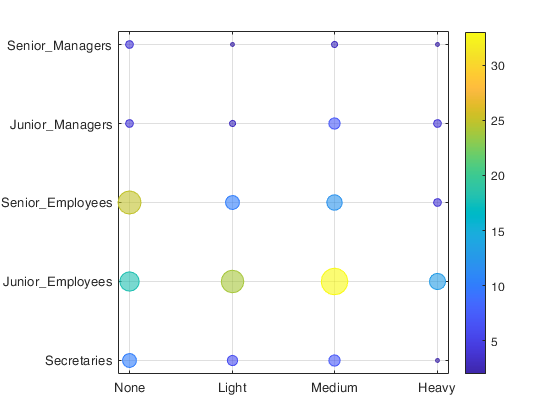balloonplot
balloonplot creates a balloon plot of a contingency table
Syntax
Description
A balloonplot is an alternative to bar plot for visualizing a large categorical data. It draws a graphical matrix of a contingency table, where each cell contains a dot whose size reflects the relative magnitude of the corresponding component. ballonplot is a bubble chart for contingency tables.
balloonplot with array input.h
=balloonplot(N,
Name, Value)
Examples
 balloonplot with table input.
balloonplot with table input.
 balloonplot with table input.
balloonplot with table input.Load the Housetasks data (a contingency table containing the frequency of execution of 13 house tasks in the couple).
N=[156 14 2 4;
124 20 5 4;
77 11 7 13;
82 36 15 7;
53 11 1 57;
32 24 4 53;
33 23 9 55;
12 46 23 15;
10 51 75 3;
13 13 21 66;
8 1 53 77;
0 3 160 2;
0 1 6 153];
rowslab={'Laundry' 'Main-meal' 'Dinner' 'Breakfast' 'Tidying' 'Dishes' ...
'Shopping' 'Official' 'Driving' 'Finances' 'Insurance'...
'Repairs' 'Holidays'};
colslab={'Wife' 'Alternating' 'Husband' 'Jointly'};
tableN=array2table(N,'VariableNames',colslab,'RowNames',rowslab);
% In this case a table is supplied
balloonplot(tableN);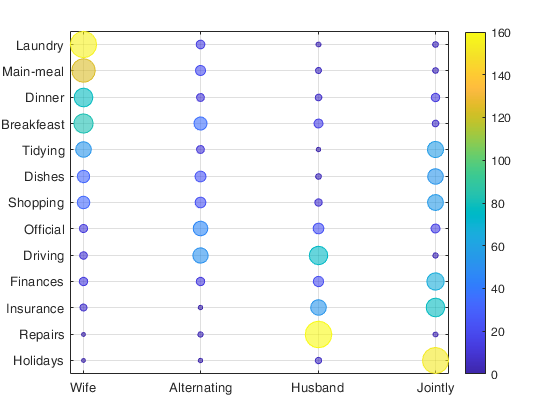
balloonplot with array input.
Load the Housetasks data (a contingency table containing the frequency of execution of 13 house tasks in the couple).
N=[156 14 2 4;
124 20 5 4;
77 11 7 13;
82 36 15 7;
53 11 1 57;
32 24 4 53;
33 23 9 55;
12 46 23 15;
10 51 75 3;
13 13 21 66;
8 1 53 77;
0 3 160 2;
0 1 6 153];
rowslab={'Laundry' 'Main-meal' 'Dinner' 'Breakfast' 'Tidying' 'Dishes' ...
'Shopping' 'Official' 'Driving' 'Finances' 'Insurance'...
'Repairs' 'Holidays'};
colslab={'Wife' 'Alternating' 'Husband' 'Jointly'};
tableN=array2table(N,'VariableNames',colslab,'RowNames',rowslab);
% In this case row and columns labels are supplied through options Lr
% and Lc
balloonplot(N,'Lr',rowslab,'Lc',colslab);
Related Examples
 balloonplot with option contrib2Index as boolean.
balloonplot with option contrib2Index as boolean.
 balloonplot with option contrib2Index as boolean.
balloonplot with option contrib2Index as boolean.Load the Housetasks data (a contingency table containing the frequency of execution of 13 house tasks in the couple).
% This ia a German sample in young, married, heterosexual couples in the late 1970s,
N=[156 14 2 4;
124 20 5 4;
77 11 7 13;
82 36 15 7;
53 11 1 57;
32 24 4 53;
33 23 9 55;
12 46 23 15;
10 51 75 3;
13 13 21 66;
8 1 53 77;
0 3 160 2;
0 1 6 153];
rowslab={'Laundry' 'Main-meal' 'Dinner' 'Breakfast' 'Tidying' 'Dishes' ...
'Shopping' 'Official' 'Driving' 'Finances' 'Insurance'...
'Repairs' 'Holidays'};
colslab={'Wife' 'Alternating' 'Husband' 'Jointly'};
% If the DimensionNames is set the xlabel and ylabel will be added
% automatically.
Ntable=array2table(N,'VariableNames',colslab,'RowNames',rowslab);
Ntable.Properties.DimensionNames=["Repartition in the couple" "13 housetasks"];
% Call to balloonplot with option 'contrib2Index' boolean equal to
% true. In this case the contributions to the Chi2 statistic
% are shown. The color is associated to the sign.
balloonplot(Ntable,'contrib2Index',true);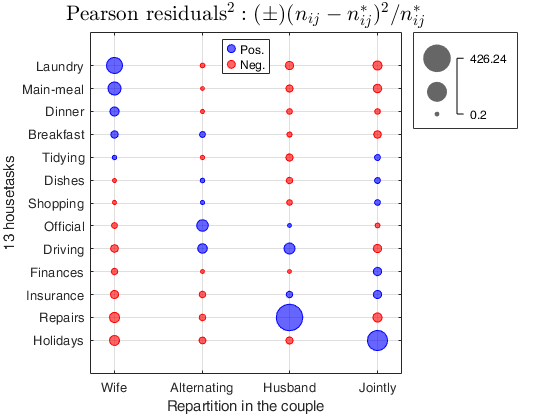
 Example of ballonplot with option contrib2Index as a matrix.
Example of ballonplot with option contrib2Index as a matrix.
 Example of ballonplot with option contrib2Index as a matrix.
Example of ballonplot with option contrib2Index as a matrix.
load SportHealth.mat out=corrOrdinal(SportHealth); balloonplot(SportHealth,'contrib2Index',out.Contrib2CminusD) title(['Indice \gamma=' num2str(out.gam(1))])
Test of H_0: independence between rows and columns
The standard errors are computed under H_0
Coeff se zscore pval
_______ ________ ______ ____
gamma 0.59385 0.053088 11.186 0
taua 0.33958 0.03852 8.8157 0
taub 0.45635 0.040796 11.186 0
tauc 0.45128 0.040343 11.186 0
dyx 0.4525 0.040451 11.186 0
-----------------------------------------
Indexes and 95% confidence limits
The standard error are computed under H_1
Value StandardError ConflimL ConflimU
_______ _____________ ________ ________
gamma 0.59385 0.04837 0.49905 0.68866
taua 0.33958 0.011291 0.31745 0.36171
taub 0.45635 0.040331 0.3773 0.5354
tauc 0.45128 0.040343 0.37221 0.53036
dyx 0.4525 0.040106 0.37389 0.53111
ans =
Figure (pl_balloonplot) with properties:
Number: 4
Name: ''
Color: [0.9608 0.9608 0.9608]
Position: [1 1 1536 744]
Units: 'pixels'
Use GET to show all properties
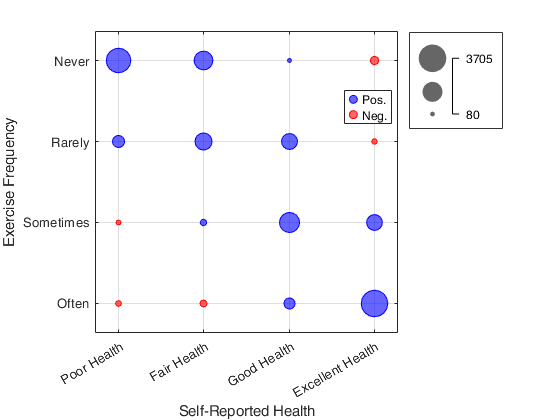
 Example where contrib2Index is a table.
Example where contrib2Index is a table.
 Example where contrib2Index is a table.
Example where contrib2Index is a table.
load SportHealth.mat out=corrNominal(SportHealth); out.Contrib2Hyxtable % Contribution to Hyx index from each cell of the table balloonplot(SportHealth,'contrib2Index', out.Contrib2Hyxtable) title(['Contribution of each single cell to Hyx=' num2str(out.Hyx(1))])
Chi2 index
104.4294
pvalue Chi2 index
1.9934e-18
Phi index
0.5871
Cramer's V
0.3389
Test of H_0: independence between rows and columns
Coeff se zscore pval
_______ ________ ______ __________
CramerV 0.33895 0.040732 8.3214 0
GKlambdayx 0.19307 0.044247 4.3634 1.2803e-05
tauyx 0.11153 0.021133 5.2774 1.3104e-07
Hyx 0.12654 0.022713 5.5711 2.531e-08
-----------------------------------------
Indexes and 95% confidence limits
Value StandardError ConflimL ConflimU
_______ _____________ ________ ________
CramerV 0.33895 0.040732 0.25911 0.39187
GKlambdayx 0.19307 0.044247 0.10635 0.27979
tauyx 0.11153 0.021133 0.070107 0.15295
Hyx 0.12654 0.022713 0.082019 0.17105
ans =
4×4 table
Poor Health Fair Health Good Health Excellent Health
___________ ___________ ___________ ________________
Never 0.065383 0.030991 -0.020606 -0.016491
Rarely 0.0011911 0.01432 0.0059075 -0.015609
Sometimes -0.012717 -0.013736 0.04043 0.0057804
Often -0.0086721 -0.0125 -0.0060879 0.068952
ans =
Figure (pl_balloonplot) with properties:
Number: 5
Name: ''
Color: [0.9608 0.9608 0.9608]
Position: [1 1 1536 744]
Units: 'pixels'
Use GET to show all properties
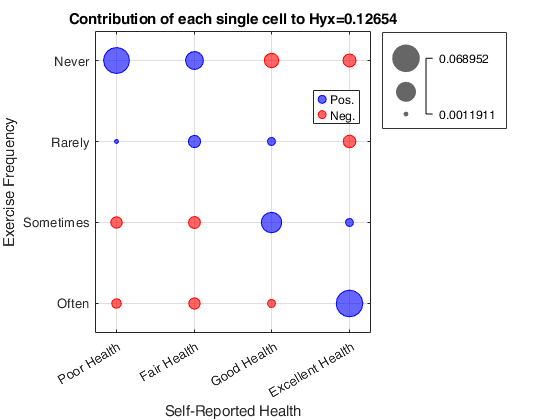
Analyse several datasets and visualise them only at the end.
% Set the default figure visibility to off
set(0, 'DefaultFigureVisible', 'off');
load SportHealth.mat
out=corrNominal(SportHealth);
out.Contrib2Hyxtable
balloonplot(SportHealth,'contrib2Index', out.Contrib2Hyxtable);
load smoke
[h,Ntable]=balloonplot(smoke,'datamatrix',true);
% the figures remain invisible for 5 seconds
disp('Figures generated! They remain invisible for 3 seconds');
pause(5);
% now they become visible again
h_figures = findobj('Type', 'figure', 'Tag', 'pl_balloonplot');
set(h_figures, 'Visible', 'on');
% Do not forget to set again the default figure visibility to on!
set(0, 'DefaultFigureVisible', 'on');
cascade;Input Arguments
N — Contingency table (default) or n-by-2 input dataset.
2D Array or Table.
2D array or table which contains the input contingency table (say of size I-by-J) or the original data matrix X.
In this last case N=crosstab(X(:,1),X(:,2)). As default procedure assumes that the input is a contingency table.
Data Types: single| double
Name-Value Pair Arguments
Specify optional comma-separated pairs of Name,Value arguments.
Name is the argument name and Value
is the corresponding value. Name must appear
inside single quotes (' ').
You can specify several name and value pair arguments in any order as
Name1,Value1,...,NameN,ValueN.
'ax',myaxes
, 'contrib2Index',true
, 'datamatrix',true
, 'Lr',{'a' 'b' 'c'}
, 'Lc',{'c1' c2' 'c3' 'c4'}
ax
—displays the bubble chart in the target axes ax.axes object.
If you do not specify the axes, MATLAB plots into the current axes, or it creates an Axes object if one does not exist.
Example: 'ax',myaxes
Data Types: Axes object
contrib2Index
—bubble chart of contribution to a statistic index.boolean | matrix (table) of size IxJ.
If this option is true, squared Pearson residuals are computed and shown through bubble chart. Squared Pearson residuals associated with positive (negative) associations are shown in blue (red). Pearson residuals are defined as $\frac{n_{ij}-n_{ij}^*}{\sqrt{n_{ij}^*}}$ where $n_{ij}$ is the $i,j$ entry of the input contingency table N and $n_{ij}^*$ is the theoretical frequency under the independence hypothesis. The sum of the squares of the Pearson residuals is equal to the $\chi^2$ statistic to test the independence between rows and columns of the contingency table. The default value of contrib2Index is false that is no transformation is done on the orginal contingency table. If contrib2Index is equal to a matrix of size IxJ the balloon plots shows circles which are proportional to the absolute values of this matrix.
Example: 'contrib2Index',true
Data Types: boolean or array or table of the same size of N
datamatrix
—Data matrix or contingency table.boolean.
If datamatrix is true the first input argument N is forced to be interpreted as a data matrix, else if the input argument is false N is treated as a contingency table. The default value of datamatrix is false, that is the procedure automatically considers N as a contingency table (in array or table format). If datamatrix is true, N can be an array or a table of size n-by-2. Note that if N has more than two columns balloonplot is based on the first two columns of N (and a warning is produced).
Example: 'datamatrix',true
Data Types: logical
Lr
—Vector of row labels.cell.
Cell containing the labels of the rows of the input contingency matrix N. This option is unnecessary if N is a table, because in this case Lr=N.Properties.RowNames;
Example: 'Lr',{'a' 'b' 'c'}
Data Types: cell array of strings
Lc
—Vector of column labels.cell.
Cell containing the labels of the columns of the input contingency matrix N. This option is unnecessary if N is a table, because in this case Lc=N.Properties.VariableNames;
Example: 'Lc',{'c1' c2' 'c3' 'c4'}
Data Types: cell array of strings
Output Arguments
h —returns the BubbleChart object.
Use h to modify properties of
the chart after creating it
For a list of properties, see BubbleChart Properties.
Ntable —$I$-by-$J$ contingency table.
Table
This is tha table which has been used to build the balloonplot.
